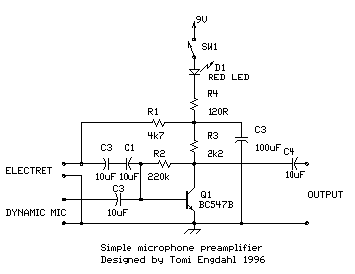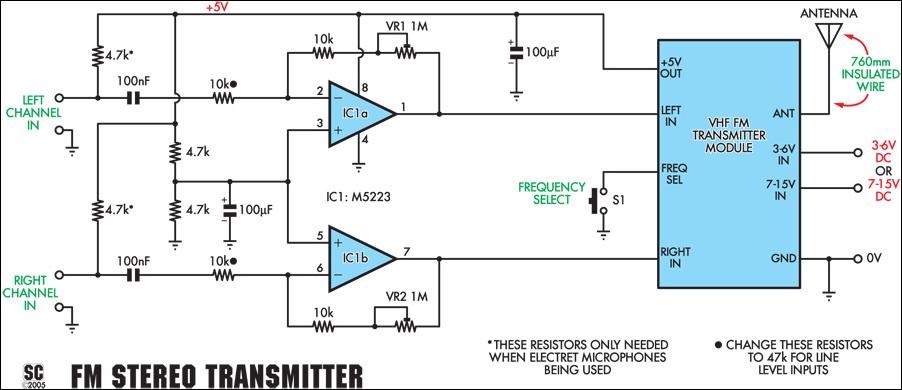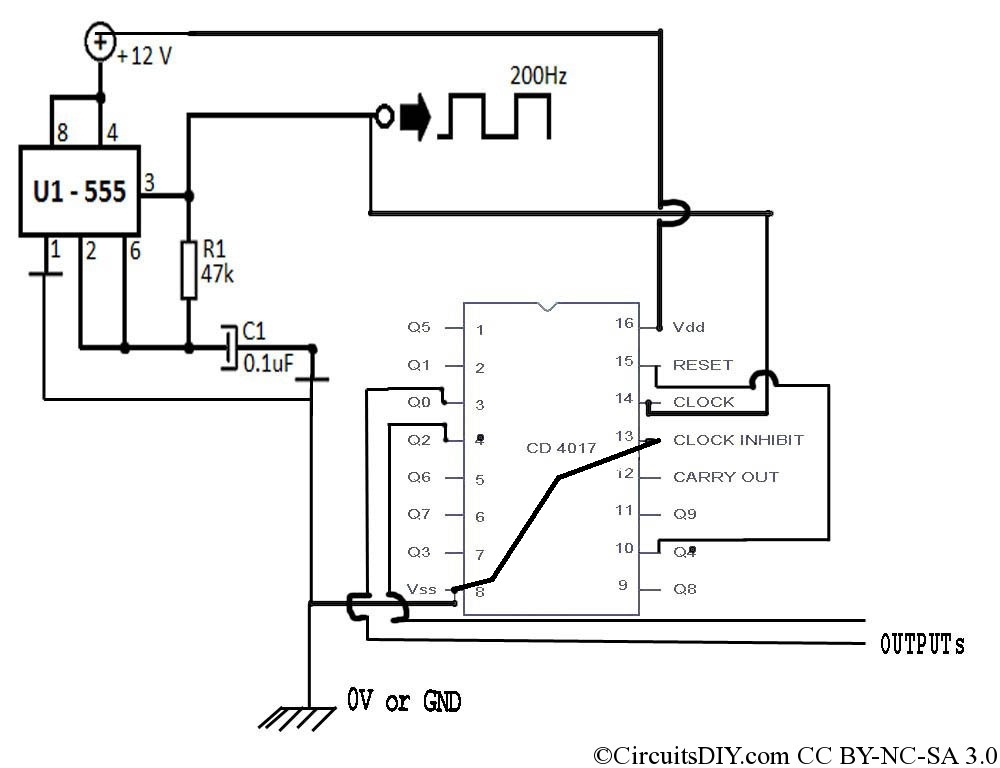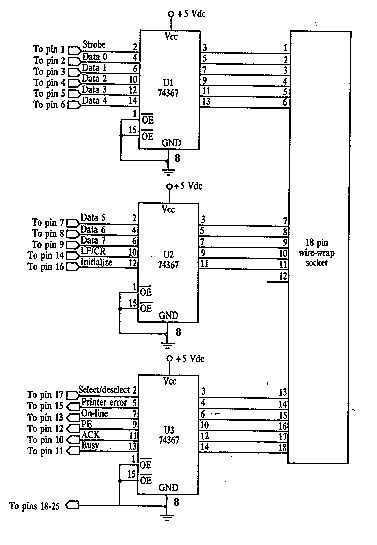
simple microphone preamplifier

This is a simple microphone preamplifier circuit that can be used between a microphone and a stereo amplifier. This circuit is suitable for connection with standard home stereo amplifier line/CD/aux/tape inputs. The microphone preamp can accommodate both dynamic and electret microphone inputs, as it provides power for electret microphone elements. The design aims to be straightforward for ease of construction. The performance of the circuit is adequate for casual projects, featuring a simple one-transistor amplifier with a gain of approximately 30-40 dB, which varies based on the transistor type, temperature, and voltage. The dynamic microphone input consists of a basic one-transistor amplifier circuit. The electret microphone input includes a resistor (R1) to supply current to the electret microphone capsule when connected. Electret microphones require around 1 mA of current to function due to the small amplifier circuit within the microphone capsule. This circuit is compatible with typical low-cost electret capsules available from electronic component retailers. However, due to the higher signal output of electret microphones, there is a risk of overdriving the amplifier when high sound levels are encountered.
This microphone preamplifier circuit serves as a bridge between various types of microphones and stereo amplifiers, offering flexibility in audio input options. The circuit's simplicity is a key feature, as it allows for easy assembly and integration into different audio projects.
The core of the circuit utilizes a single transistor, which serves as the primary amplification stage. The choice of transistor can significantly influence the performance characteristics, including the gain, frequency response, and overall sound quality. The gain of 30-40 dB is sufficient for most casual applications, providing a noticeable enhancement of the microphone signal without introducing excessive noise.
For the electret microphone input, the inclusion of resistor R1 is critical, as it ensures that the electret capsule receives the necessary bias current for its internal amplifier to operate effectively. This resistor value must be selected carefully to ensure optimal performance, considering the specific requirements of the electret microphone being used. It is important to note that the electret microphone's output signal can be significantly higher than that of a dynamic microphone, which necessitates careful handling to avoid signal distortion or clipping, particularly in high-volume situations.
The circuit's compatibility with inexpensive electret capsules makes it an accessible solution for hobbyists and engineers looking to enhance audio input capabilities without substantial investment. The design can be further refined by incorporating additional components, such as capacitors for filtering and improving frequency response or using a more sophisticated transistor configuration to enhance performance.
Overall, this microphone preamplifier circuit provides a practical solution for amplifying audio signals from various microphone types, making it suitable for a range of applications, from home audio systems to DIY audio projects.This is a simple microphone preamplifer circuit which you can use betw1een your microphone and stereo amplifier. This circuit amplifier microphone suitable for use with normal home stereo amplifier line/CD/aux/tape inputs.
This mic preamp can take both dynamic and electret microphone inputs (preamplifer provides power foe electret microphone eleme nts). The idea of this circuit is to keep the design as simple as possible to be easy to build. That was my goal when I needed a simple external microphone preamplifer for my mixer. The performance of the circuit is nothing superior but can be used with many not so serious projects. The circuit is a simple one transistor amplifier with amplification of about 30-40 dB (depends on transitor, temperature and voltage).
The dynamic mic input is just a simple one transistor amplifier circuit with nothing special. Electret microphone input has a resistor R1 fo feeding current through electret microphone capsule when it is connected to the electret microphone input. Electret microphone needs some current (about 1 mA) flowing through it to operate, because there is a small amplifier circuit inside the microphone capsule.
This circuit is suitable for all typical cheap electret campsules which available from any electronic component shop. Because electret microphones have higher signal level output, it is quite easy to overdrive the amplifier when you shout to electret microphone.
🔗 External reference
This microphone preamplifier circuit serves as a bridge between various types of microphones and stereo amplifiers, offering flexibility in audio input options. The circuit's simplicity is a key feature, as it allows for easy assembly and integration into different audio projects.
The core of the circuit utilizes a single transistor, which serves as the primary amplification stage. The choice of transistor can significantly influence the performance characteristics, including the gain, frequency response, and overall sound quality. The gain of 30-40 dB is sufficient for most casual applications, providing a noticeable enhancement of the microphone signal without introducing excessive noise.
For the electret microphone input, the inclusion of resistor R1 is critical, as it ensures that the electret capsule receives the necessary bias current for its internal amplifier to operate effectively. This resistor value must be selected carefully to ensure optimal performance, considering the specific requirements of the electret microphone being used. It is important to note that the electret microphone's output signal can be significantly higher than that of a dynamic microphone, which necessitates careful handling to avoid signal distortion or clipping, particularly in high-volume situations.
The circuit's compatibility with inexpensive electret capsules makes it an accessible solution for hobbyists and engineers looking to enhance audio input capabilities without substantial investment. The design can be further refined by incorporating additional components, such as capacitors for filtering and improving frequency response or using a more sophisticated transistor configuration to enhance performance.
Overall, this microphone preamplifier circuit provides a practical solution for amplifying audio signals from various microphone types, making it suitable for a range of applications, from home audio systems to DIY audio projects.This is a simple microphone preamplifer circuit which you can use betw1een your microphone and stereo amplifier. This circuit amplifier microphone suitable for use with normal home stereo amplifier line/CD/aux/tape inputs.
This mic preamp can take both dynamic and electret microphone inputs (preamplifer provides power foe electret microphone eleme nts). The idea of this circuit is to keep the design as simple as possible to be easy to build. That was my goal when I needed a simple external microphone preamplifer for my mixer. The performance of the circuit is nothing superior but can be used with many not so serious projects. The circuit is a simple one transistor amplifier with amplification of about 30-40 dB (depends on transitor, temperature and voltage).
The dynamic mic input is just a simple one transistor amplifier circuit with nothing special. Electret microphone input has a resistor R1 fo feeding current through electret microphone capsule when it is connected to the electret microphone input. Electret microphone needs some current (about 1 mA) flowing through it to operate, because there is a small amplifier circuit inside the microphone capsule.
This circuit is suitable for all typical cheap electret campsules which available from any electronic component shop. Because electret microphones have higher signal level output, it is quite easy to overdrive the amplifier when you shout to electret microphone.
🔗 External reference




